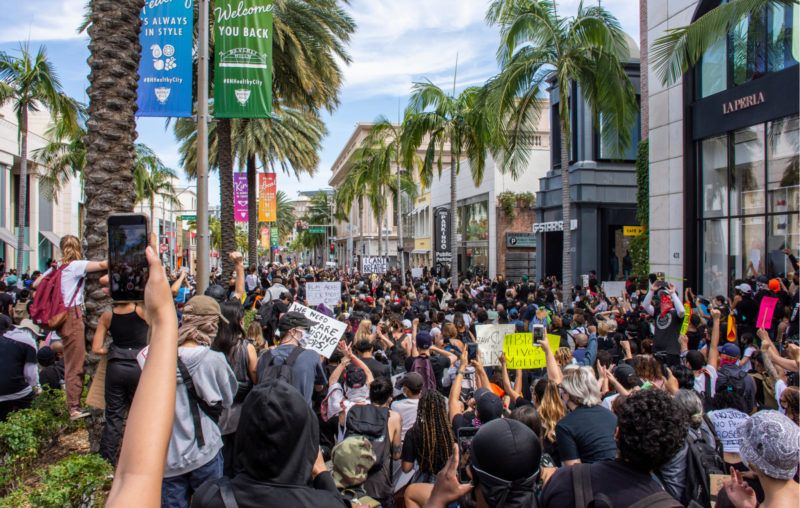How We Got Into this Mess

In one of a growing number of Californian protests against the state’s three-month-old coronavirus lockdown, one woman hoisted a sign saying: “We’ve tried communism, now give us back our liberties.” She may have to wait awhile. Individual liberty doesn’t have a high priority these days in Sacramento and some other capitals of populous blue states.
To the contrary, California Governor Gavin Newsom takes pride in the fact that as of May 31, California had suffered only 4,213 COVID-19 deaths, statistically insignificant in a population of nearly 40 million. Following the national pattern, about half those deaths occurred in nursing homes heavily populated with elderly people with other life-threatening maladies. He thinks his “mitigation” measures worked.
But as new data has emerged, it has become evident that the early fears of the coronavirus, particularly as a threat to healthy people under 65, were grossly exaggerated.
Yet fear is still very much in the saddle nationwide and it is slowing the lifting of restrictions and allowing people to return to a normal life.
We have been assured that lockdowns have reduced the COVID-19 death toll, now at over 100,000 nationwide, but that implies a knowledge of what might have been, something we don’t have. For example, we don’t know if the ultimate death toll would have been lower if states had used lighter measures and allowed the infections to bring about herd immunity, through which viruses normally play themselves out.
What we do know is that many states, especially highly populated ones like California and New York, put heavy constraints on individual freedom, destroying productive activities and causing havoc. By one estimate, lockdowns are costing the nation some $80 billion a week in lost production.
California’s March 20 lockdown order was among the most sweeping. It shut down parks, beaches, schools, restaurants, film studios–you name it. Tom Steyer, the radical environmentalist and erstwhile Democratic presidential candidate, aptly described the result as an “economic free fall.” In Los Angeles, unemployment shot up to a Great Depression level of 24%. A state budget deficit of $54 billion now looms and it could go higher if the state is slow to lift restrictions.
Mr. Steyer has assembled a business-labor-political coalition to try to organize a recovery. That’s ironic because Mr. Steyer has been among the Democratic Party luminaries who for years have been using the politics of fear to expand the powers of the state in the name of warding off “climate change.” Barack Obama used this bogeyman unscrupulously as he tightened his grip on the energy industry. New York governor Andrew Cuomo set about to counter the “threat” by spending billions the state doesn’t have to erect windmills in the Atlantic Ocean.
Efforts to stir up public fears of “climate change” became increasingly ineffective as the apocalypse predicted by Al Gore 30 years ago didn’t show up. But something real did show up when China belatedly got around to revealing that it had launched a new coronavirus into worldwide circulation.
A highly-dubious computer model quickly whipped up at the Imperial College London predicted 500,000 deaths in the U.K. and 2 million in the U.S., stirring a panic. Donald Trump was skeptical at first, then tried a bold leadership stance and finally invited state governors to take over “mitigation.”
Blue state governors, especially, relished the power and glory of crisis management. Virginia’s governor Ralph Northam scheduled a 72-day shutdown, the longest for any state, without much data on the extent of the danger. New Jersey governor Phil Murphy sent officers to a synagogue funeral to enforce “social distancing.”
When Fox TV host Tucker Carlson asked, “By what authority did you nullify the Bill of Rights in issuing this order?” the former Goldman Sachs partner replied: “That’s above my pay grade. I wasn’t thinking of the Bill of Rights when we did this.” He said he was thinking of “science,” presumably of the same quality as the computer models that 30 years ago told us that by this time the world would be frying from “climate change” if we keep burning fossil fuels.
Chucked into the wastebasket along with the Bill of Rights was fiscal restraint. Modern Monetary Theory, actually an ancient pie-in-the-sky notion recently resurrected by State University of New York at Stony Brook professor Stephanie Kelton, marched into the House of Representatives and took over, giving Nancy Pelosi and her followers permission to spend unlimited amounts of borrowed money to relieve the misery caused by the lockdowns.
The Care Act was the result, and $2.7 trillion was added to the federal budget deficit. Ms. Pelosi, thus unchained, proposed to spend yet another $3 trillion, which began to stir some belated uneasiness among Republicans, including Trump, who had previously offered little resistance to this wild flight from fiscal reality.
The Democratic Party’s star economic philosophers have been unperturbed. On May 14, Princeton professor Alan S. Blinder, a former vice chairman of the Federal Reserve Board, wrote a piece for The Wall Street Journal invoking the memory of Scarlett O’Hara and her “Gone With the Wind” line, “I’ll think about that tomorrow.” The gist: no one knows how large the national debt can go before it becomes unsustainable but so far there are no danger signals, like higher interest rates or a sagging dollar, in international markets.
Democrats argue that profligate spending so far has not provoked inflation, as traditional economic theory would have predicted. The Fed has prevented that in the past by locking up excess bank reserves. But it should be noted that the U.S. dollar is being sharply devalued in relation to a form of money still worthy of respect, gold. Since the coronavirus panic began in February, the dollar price of gold has been rising at an annual rate of 25%.
How long can we get by with this? Yet another Democratic economist, former Clinton Treasury Secretary and then-Obama economic adviser Lawrence E. “Larry” Summers seems as unconcerned as Professor Blinder. In a podcast from Princeton’s Bendheim Center for Finance on May 22, he equated the government spending needed to compensate for the soaring costs of the lockdowns as something similar to that needed for the WWII Manhattan Project, which produced the atom bomb.
What he fails to mention is that the cost of the Manhattan Project in today’s money was only about $70 billion, considerably less than the $5 trillion they’re cooking up in Nancy Pelosi’s shop.
Professor Blinder cites Scarlett. As the lockdown costs mount, restless and angry people riot in the streets without social distancing, and a broad public continues to be blocked by regulations and their own fears from resuming productive lives, perhaps another movie would be a more appropriate allusion. How about the title of that film classic about alcoholism, “I’ll Cry Tomorrow”?










